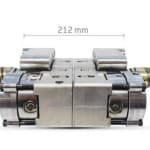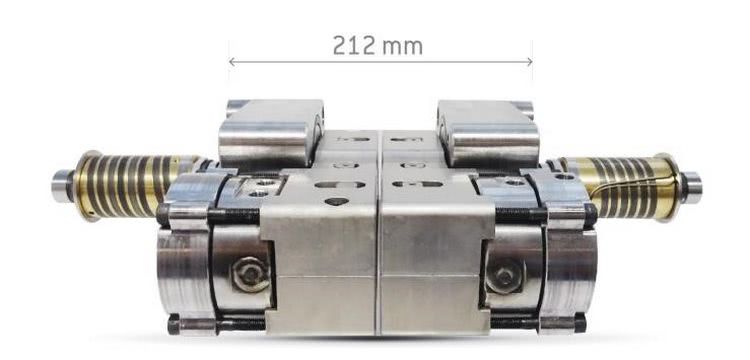 Specifically for the construction of stack molds, HRSflow showcased a new addition to its product range at Fakuma 2018, namely a special low-height actuator for hot runner valve gate systems. The advantage of this 'Compact Stack Mold' technology is derived from the staggered arrangement of the cylinders to the side of the nozzle and the use of rocker levers to transmit the movement from the cylinder to the needle and tip solution used.
Specifically for the construction of stack molds, HRSflow showcased a new addition to its product range at Fakuma 2018, namely a special low-height actuator for hot runner valve gate systems. The advantage of this 'Compact Stack Mold' technology is derived from the staggered arrangement of the cylinders to the side of the nozzle and the use of rocker levers to transmit the movement from the cylinder to the needle and tip solution used.Stack molds made in this way have much lower construction heights than versions in which the cylinders and needles are aligned. The required plate thickness is then 132 mm for offset nozzles and 212 mm for in line nozzles in the case of HRSflow's Ga range designed for medium to large shot weights. Available for PP, ABS and PC/ABS, this new technology is mainly used for big automotive parts such as bumpers and non-automotive applications such as bins or pallets. Stephan Berz, Vice President HRSflow Sales, states: "Stack molds with a lower height often allow the use of smaller injection molding machines, which then lead to much lower running costs. In this way, our 'Compact Stack Tool' technology helps to make the operation of stack molds even more economical."

At Fakuma 2018, HRSflow showcased space-saving versions of the actuating cylinder for hot runner systems that enable stack molds with low plate heights.
Stack molds…
… have two or more parting lines. This makes it possible to fill cavities arranged in a row with one shot, thus increasing productivity. Typical applications include, for example, the simultaneous manufacture of differently shaped parts that are then immediately assembled to create a sub-assembly. Although the addition of a further cavity level allows a correspondingly higher shot volume, it does not bring about any increase in the required locking forces. Nevertheless, the mold weight rises due to the larger number of plates, and the fact that the tie bar guides for the moving mold halves and the support of the plates must have sufficient stability. Because HRSflow's new, low-height 'Compact Stack Mold' technology allows thinner plates, the guide and support elements can accordingly be designed smaller, thus saving additional costs.Source: HRSflow



